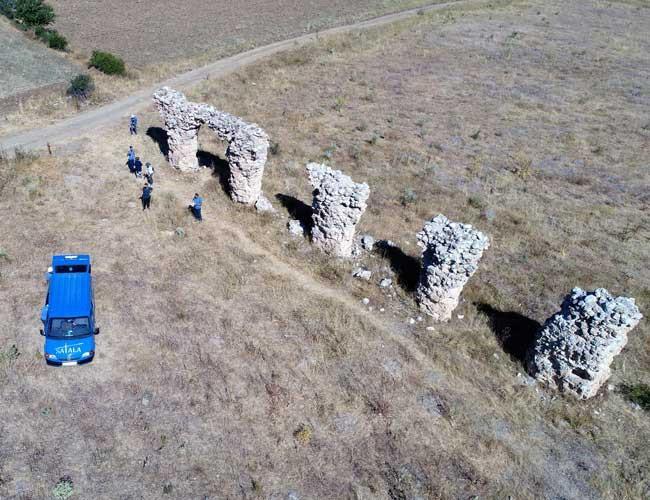
Prior to the archeological excavations planned to start next year in the ancient city of Satala located in the Black Sea province of Gümüşhane, geophysics work has been initiated in order to collect data on the site. Satala was built as a military headquarter during the Roman Empire.
The studies carried out by the permission of the Culture and Tourism Ministry in Satala located within the borders of the Sadak village in the province of Gümüşhane’s Kelkit district, are also supported by the Gümüşhane Governorate.
The head of the excavation and Bartın University Archeology Department Faculty Member Assistant Professor Şahin Yıldırım, told state-run Anadolu Agency ancient Satala was one of the most important cities of the Roman Empire in the east.
Yıldırım said the Euphrates River made the east border of the Roman Empire and four big legions (military headquarters) were situated along the river.
One of these legions was the 15th Apollon legion in ancient Satala. The legion fortresses were built to protect the city from attack. They were military institutions with a first and second army structure like in the Turkish army system.
Yıldırım said the legions were self-sufficient regarding all their needs.
“The main factor in the growth of Satala is the 15th Apollo legion. A legion was composed of roughly 5,000 people. Among them, there were 3,500 legionaries and cavalries and 1,500 elements for support services. We see Satala is a city shaped by the legion fortress. When we look at its population in ancient times, we can say there were at least 10,000-15,000 people,” he added.
Yıldırım also said they identified the excavation areas and studies this year were being carried out regarding the geophysics measurements, identification of the excavation areas, building of the excavation house and the surface surveys in the area.
He said visible historical artifacts in the area would be restored.
“According to us, Satala is the only ancient city in Turkey where an excavation about the Roman military architecture can be made. This will be the first place where a legion fortress is excavated in Turkey. We hope to come across very important clues about the military architecture of the buildings and the Roman military system,” he added.
After the infrastructure work, the officials plan to start next year with archeological excavations in hopes to see the historical stages the legion fortress has been through.
Expectations quite high
Yıldırım said ancient Satala was a settlement arranged by the Roman city system and their expectations from the excavations were quite high.
“According to us, the most important place is the 15th legion headquarter. We will probably see the stages this city went through in the Parthians, Sasanians, Byzantium and Roman periods. We will come across the ruins of the military architecture. We are planning to open the city’s important constructions and building areas, the Roman villas, settlement areas and the related parts. The whole historic duration of the Roman Empire and its fate in Anatolia ends here. The legion is erased here from its historic stage. The fact the legion was built and disappeared in this area is also very important. We will also see how the 15th legion started and how it ended by the excavations we will carry out,” he said.
Yıldırım drew attention to the similarities between Satala and Zeugma and said both of the ancient cities were military garrison cities located on trade roads.
“Zeugma and Satala share the same fortune. Both of them were destroyed in a night raid by the Sasanian King in 226 A.C. and afterwards these legions were erased from the stage of history,” he said.
Yıldırım said these cities were where the nobles, wealthy tradesmen and the soldiers in Rome lived.
“In Zeugma, there were villas, with richly decorated mosaics on the floors and colorful frescos on their walls. We can say there were similar villas in Satala as well. There is a bust of Aphrodite, which was smuggled from here in the 19th century and today it is exhibited in the British Museum in London. This is an artifact showing the importance of Satala. Along with this, it is a melted and a burnt artifact. We have seen similar ones in the Zeugma excavations. Having artifacts of such importance in the city show Satala was not only a legion in Roman times but also a strong city in regard to commercial and economic means.” he added.
Legion and the city will be visible
Together with the excavation work in the area, some experimental archeological work will also be carried out.
“This work will pick up speed as they receive financial support from the Culture and Tourism Ministry and the Gümüşhane Governorate. These are studies that can last 40-50 years. The archeological studies are long term projects. We believe the legion and the city can become visible in the coming 10 years,” said Yıldırım.
The provincial head of culture and tourism, Hüseyin Ateş also brought to mind the ancient city of Satala was registered by the Culture and Tourism Ministry in 1988.
Ateş said surface surveys were done more frequently after 2000. “Exposing the 15th legion as a result of the excavation means this area will become one of the most important touristic destinations in the Black Sea region,” he said.